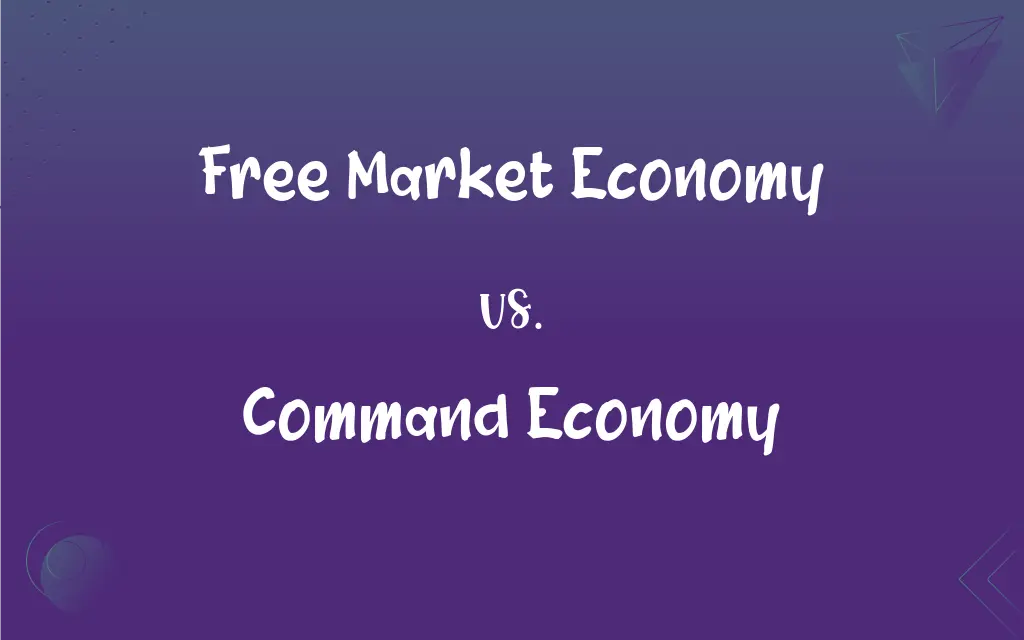Free Market Economy vs. Command Economy: What's the Difference?
Edited by Janet White || By Harlon Moss || Updated on October 25, 2023
A free market economy is driven by individual choices and supply-demand; a command economy is controlled by the government.

Key Differences
A free market economy is a system where the forces of supply and demand, without any interventions by the government, determine the production of goods and services. Prices, production, and distribution in such an economy are mainly determined by the decisions and choices of individual sellers and buyers. On the other hand, a command economy, also known as a centrally planned economy, is characterized by significant government intervention. The government, rather than the market, determines what goods should be produced, how much should be produced, and the price at which the goods will be offered for sale.
The core distinction between a free market economy and a command economy lies in the degree of governmental intervention in the economic processes. While the free market economy limits government interference, allowing market forces to guide the economy, a command economy tends to have substantial governmental control, directing almost all economic activity. Such control can range from setting prices, deciding on the production quantities, to choosing distribution methods.
Free market economies tend to foster innovation and competition among businesses. When businesses compete, consumers often benefit from better products, lower prices, and enhanced services. Conversely, a command economy lacks such competition since the government controls production and pricing. As a result, there's limited incentive for innovation, leading to potential stagnation in various industries.
Another contrasting point is the allocation of resources. In a free market economy, resources are allocated based on the demand of consumers and the supply by producers, often leading to a self-regulating, efficient economy. In contrast, a command economy might face challenges in resource allocation due to lack of real-time market feedback, which can lead to shortages or surpluses.
Comparison Chart
Decision Making
Based on individual choices.
Centralized by the government.
ADVERTISEMENT
Price Determination
By forces of supply and demand.
Set by the government.
Resource Allocation
According to market demand and supply.
Based on government planning.
Innovation and Competition
Encouraged due to competition.
Limited due to lack of competitive environment.
Efficiency
Often efficient due to market feedback.
Can face inefficiencies due to lack of market signals.
Free Market Economy and Command Economy Definitions
Free Market Economy
An economy that promotes competition and individual enterprise.
A free market economy can lead to innovation and growth.
ADVERTISEMENT
Command Economy
A centrally planned economy with little or no reliance on market forces.
In a command economy, the government determines which goods and services are produced.
Free Market Economy
An economic system with minimal government intervention in business practices and transactions.
A free market economy can adjust dynamically to consumer needs.
Command Economy
An economic system where the government makes all the primary decisions regarding production, distribution, and consumption.
The former Soviet Union was a notable example of a command economy.
Free Market Economy
An economic system based on supply and demand with little or no government control.
The U.S. largely operates on a free market economy.
Command Economy
Economic structure where resource allocation, prices, and quantities are centrally decided.
Shortages can occur in a command economy if the central planning is inaccurate.
Free Market Economy
A system where prices for goods and services are set freely by the forces of supply and demand.
In a free market economy, producers decide what to produce based on consumer demand.
Command Economy
An economy where private enterprise is limited and the state has broad control over resources.
A command economy can reduce disparities between rich and poor.
Free Market Economy
Economic structure where most decisions are made by individual consumers and firms.
Consumer preferences drive production in a free market economy.
Command Economy
A system where economic activities, including pricing and production, are directed by the government.
In a command economy, the government can prioritize essential industries.
FAQs
What is a command economy?
A command economy is a system where the government, rather than market forces, determines what goods are produced, how much is produced, and the price at which they're sold.
How do free market economies adjust to changing conditions?
Through the forces of supply and demand, which automatically adjust prices, production, and distribution as conditions change.
What is a free market economy?
A free market economy is a system where prices for goods and services are determined by the open market and consumers, without government intervention.
What are some advantages of a free market economy?
Efficiency, innovation, consumer choice, and economic growth are often cited advantages due to competition and consumer preferences.
What are potential downsides of a command economy?
Reduced efficiency, lack of innovation, shortages or surpluses of goods, and limited consumer choice can occur due to lack of market-driven flexibility.
Do command economies discourage entrepreneurship?
Since the state controls production and distribution, there's typically less room for individual entrepreneurship compared to free market economies.
How are resources allocated in a free market economy?
Resources are allocated based on consumer demand and the profit-seeking behavior of firms.
What role do consumers play in a free market economy?
Consumers, through their buying decisions, directly influence what is produced, how much is produced, and at what price.
What's the role of private property in a free market economy?
Private property rights are foundational, allowing individuals to own, control, and profit from their resources.
What are the key principles of a free market economy?
Voluntary exchange, competition, consumer sovereignty, and the role of supply and demand in setting prices.
Who decides production in a command economy?
The government or central authority makes decisions about production, including what, how, and for whom to produce.
What is the role of profit in a free market economy?
Profit serves as an incentive for producers to meet consumer demand and encourages efficient use of resources.
Can free market economies lead to income inequality?
Yes, since income is largely determined by market forces, individuals with more valuable skills or resources may earn significantly more.
How does innovation typically differ between the two systems?
In free market economies, competition often drives innovation. In command economies, since production is state-controlled, there might be less incentive for innovation.
Is a free market economy the same as capitalism?
While they're related, they're not identical. Capitalism is an economic system based on private ownership and the profit motive, while a free market refers to the mechanism of voluntary exchange without government intervention.
How do prices get set in a command economy?
The government or central authority sets prices based on their objectives, which might be political, social, or economic.
Why might a government opt for a command economy?
To achieve specific social, political, or economic goals, or to ensure distribution of resources according to their priorities.
How does a command economy respond to inefficiencies?
Inefficiencies might persist due to lack of market feedback, but the government might make adjustments based on their objectives or perceived needs.
Can a country have a mix of both economic systems?
Yes, many countries have mixed economies, combining elements of both free market and command economies.
Are there pure free market economies in the world?
No, all economies have some level of government intervention, but some are much closer to the free market ideal than others.
About Author
Written by
Harlon MossHarlon is a seasoned quality moderator and accomplished content writer for Difference Wiki. An alumnus of the prestigious University of California, he earned his degree in Computer Science. Leveraging his academic background, Harlon brings a meticulous and informed perspective to his work, ensuring content accuracy and excellence.
Edited by
Janet WhiteJanet White has been an esteemed writer and blogger for Difference Wiki. Holding a Master's degree in Science and Medical Journalism from the prestigious Boston University, she has consistently demonstrated her expertise and passion for her field. When she's not immersed in her work, Janet relishes her time exercising, delving into a good book, and cherishing moments with friends and family.
































































